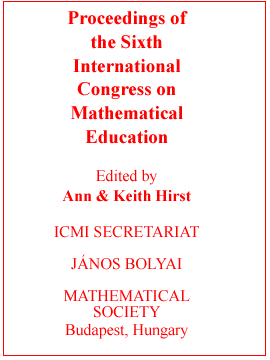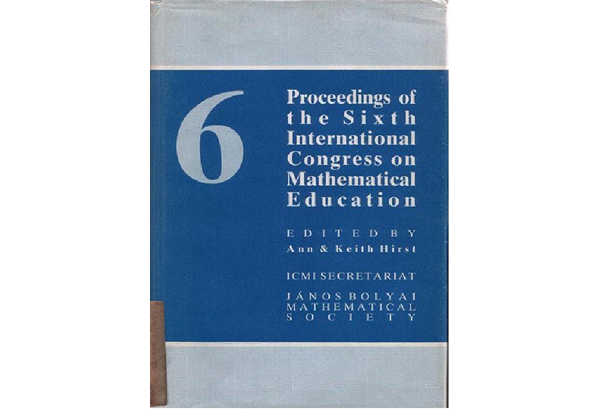 The website is in construction. New files will be uploaded as soon as they are available.
The website is in construction. New files will be uploaded as soon as they are available.
ICME-6
 |
President of ICMIJean-Pierre Kahane |
Contents
Foreword (p. 5)
Plenary Presentations
B. Nebres: School Mathematics in the 1990's: the Challenge of Change especially for Developing Countries (p. 11)
G. Vergnaud: Theoretical Frameworks and Empirical Facts in the Psychology of Mathematics Educationn (p. 29)
A. Ershov: Computerization of Schools and Mathematical Education (p. 49)
L. Lovàsz: Algorithmic Mathematics: An Old Aspect with a New Emphasis (p. 67)
J. - P. Kahane: La Grande Figure de Georges Polya (p. 79)
Action Groups
A1. L. P. Steffe: Early Childhood Years (Ages 4 - 8) (p. 101)
A2. A. C. J. Colomb: Elementary School (Ages 7-12) (p. 117)
A3. I. Hirabayashi: Junior Secondary School (Ages 11-16) (p. 133)
A4. J. Da Lange: Senior Secondary School (Ages 15-19) (p. 143)
A5. J. Mack: Tertiary (Post-Secondary) academic institutions (ages 18+) (p. 159)
A6. W. Dörfler: Pre-Service Teacher Education (p. 177)
A7. R. Strâsser: Adult, Technical and Vocational Education (p. 191)
Theme Groups
T1. P. A. House: The Profession of Teaching (p. 205)
T2. R. Fraser: Computers and the Teaching of Mathematics (p. 215)
T3. M. Niss: Problem Solving, Modelling and Applications (p. 237)
T4. D. F. Robitaille: Evaluation and Assessment (p. 253)
T5. N. Balacheff: The Practice of Teaching and Research in Didactics (p. 263)
T6. W. Blum: Mathematics and Other Subjects (p. 277)
T7. H. Burkhardt, J. A. Malone: Curriculum Towards the Year 2000 (p. 293)
Fifth Day Special: MES
A. Bishop, P. Damerow, P. Gerdes, Ch. Keitel: Mathematics, Education, Society (p. 311)

Topic Areas and International Study Groups
To1. M. Emmer: Video, Film (p. 329)
To2. I. Lénàrt: Visualization (p. 332)
To3. G. Berzsenyi: Competitions (p. 334)
To4. E. Csocsàn: Problems of Handicapped Students (p. 339)
To5. D. A. Quadling: Comparative Education (p. 342)
To6. K. J. Travers: Probability Theory and Statistics (p. 346)
To7. D. Pimm: Proofs, Justification and Conviction (p. 350)
To8. C. Laborde: Language and Mathematics (p. 354)
To9. [NOT LISTED]
To10. P. S. Kenderov: Students of High Ability (p. 358)
To11. D. Singmaster: Mathematical Games and Recreation (p. 361)
To12. [NOT LISTED]
To13. L. Burton: Women and Mathematics (p. 365)
To14. [NOT LISTED]
To15. H.-G. Steiner: Theory of Mathematics Education (p. 371)
To16. W. R. Bloom: Spaces and Geometry (p. 375)
To17. G. König: Information and Documentation (p. 379)
To18. B. Christiansen, P. F. L. Verstappen: Systematic Cooperation between Theory and Practice in Mathematics Education (p. 382)
HPM. U. D'Ambrosio: History and Pedagogy of Mathematics (p. 389)
Projects (p. 393)
ICMI
A. G. Howson: The International Commission on Mathematical Instruction (p. 395)
Notes
No date of printing is indicated. The congress was held in Budapest, July 27 - August 30. According to the Foreword, there were 2,414 registered participants from 74 countries. The role of ICMI is underlined by explaining that, as on previous occasions, the Executive Committee of ICMI set up a planning structure based on an International Programme Committee (the members are not listed). The general pattern used in Adelaide was followed (in particular, the action groups are the same as the fifth congress). The reports of the Action and Theme Groups and of the topic Areas form the major part of the volume. An additional aspect of the groups' work was the provision, in a number of cases, of a related Survey Lecture. These lectures should have been published in a separate volume. The contributions to the Fifth Day Special were published in C. Keitel, A. Bishop, P. Damerow & P. Gerdes (Eds.) Mathematics, Education, and Society. Paris, UNESCO, Science and Technology Education, Document Series, 1989. The congress included also National Presentations, Exhibitions, Poster presentations and short oral communications. Two books of abstracts were prepared for Congress Participants. The editors also write that the range of topics in these presentations was wide, the use of video materials was represented, but little emphasis was given to calculators.
One volume, format 24 cm x 16 cm; 397 pages
